Comprehensive Report on Contract Law: Elements, Terms, and Liability
VerifiedAdded on 2020/01/23
|15
|5103
|121
Report
AI Summary
This report provides a comprehensive overview of contract law, covering essential elements such as offer, acceptance, consideration, and capacity, which are crucial for a valid contract. It explores different types of contracts, including bilateral and unilateral contracts, and analyzes the significance of express and implied terms, conditions, warranties, and innominate terms within contracts. The report further delves into the application of contract elements, examining case scenarios to illustrate the practical implications of contract law principles. It contrasts liability in tort with contractual liability, focusing on negligence and vicarious liability, and applies these concepts to given business situations. The report includes an analysis of exclusion clauses and their impact, as well as implied conditions in contracts. Overall, the report offers a detailed examination of contract law, its practical applications, and the associated legal liabilities.
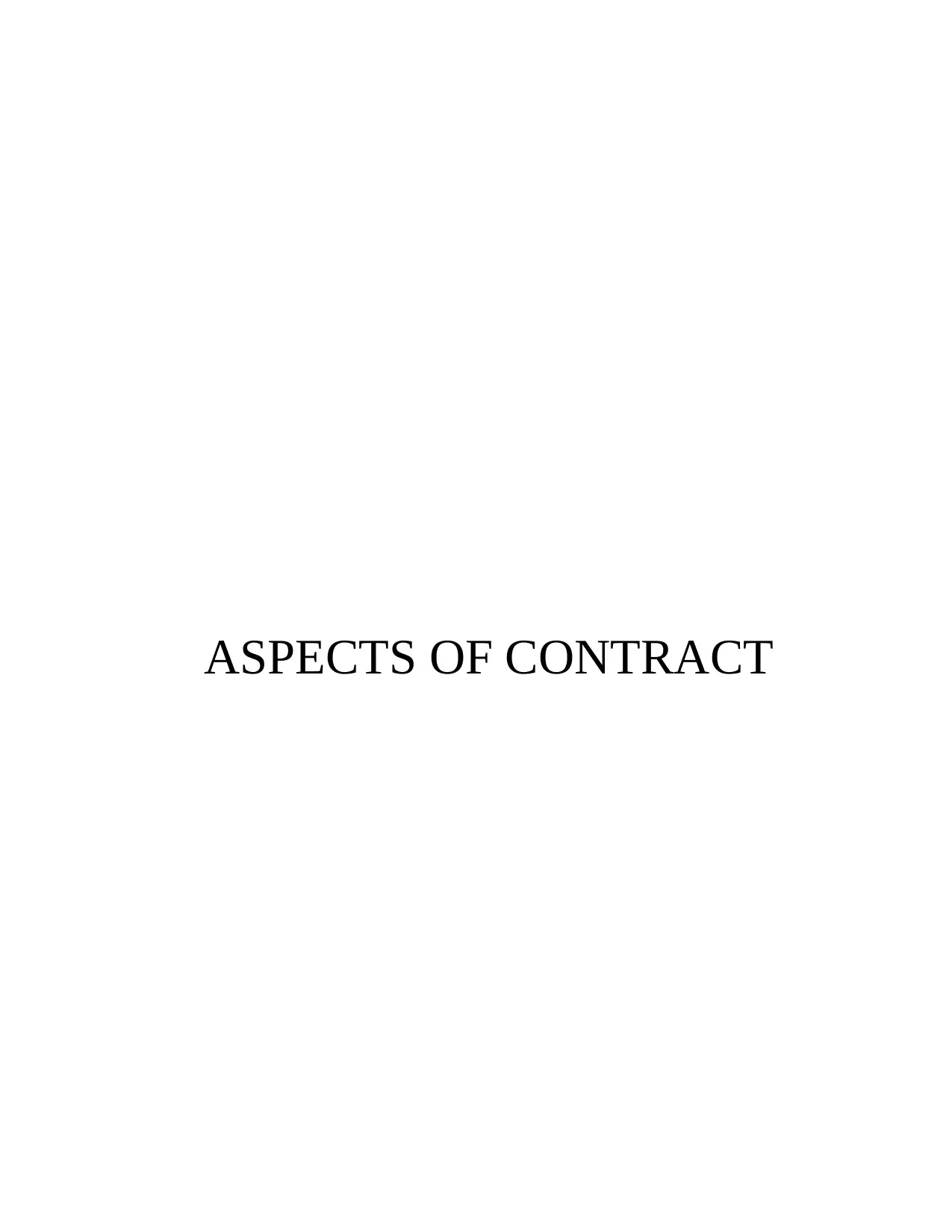
ASPECTS OF CONTRACT
Paraphrase This Document
Need a fresh take? Get an instant paraphrase of this document with our AI Paraphraser
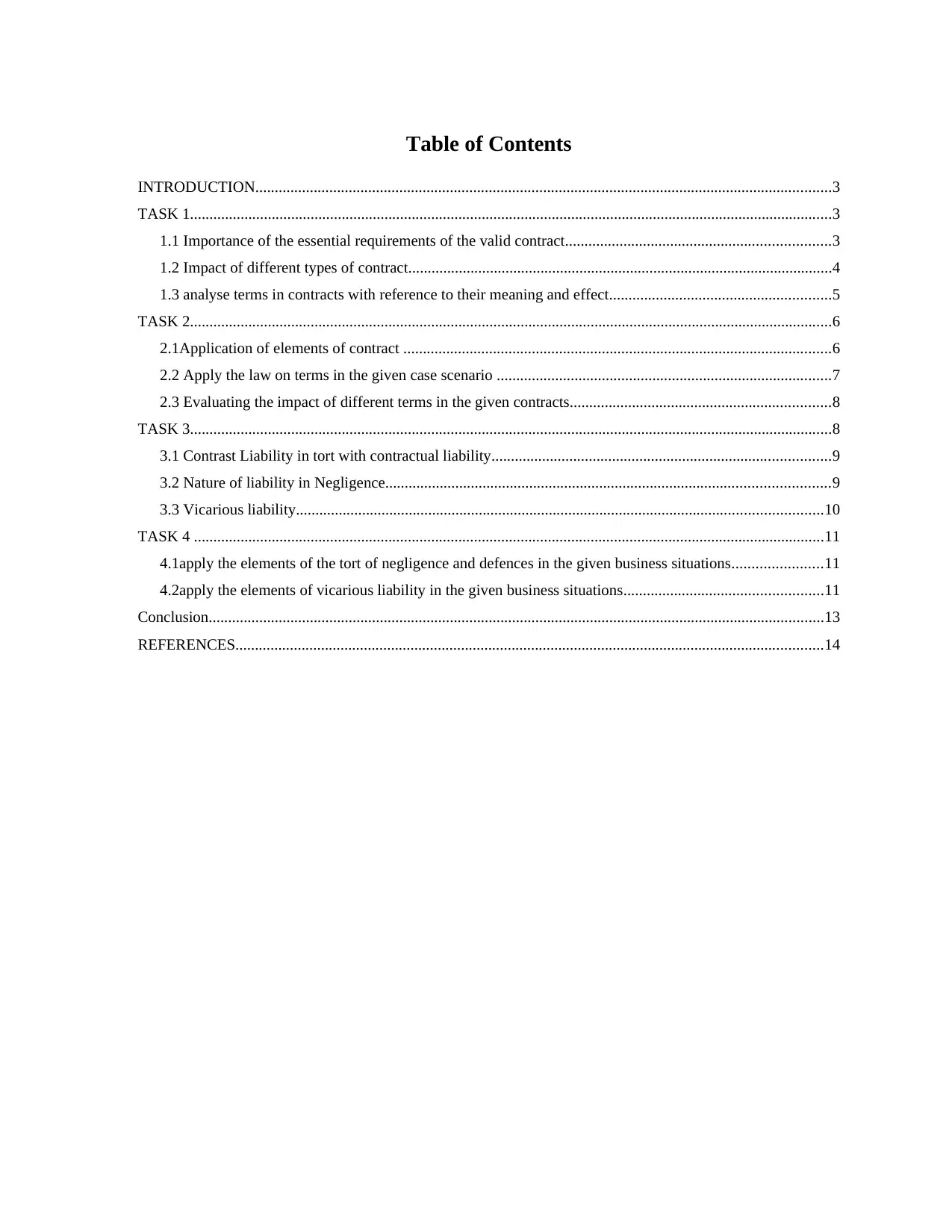
Table of Contents
INTRODUCTION....................................................................................................................................................3
TASK 1.....................................................................................................................................................................3
1.1 Importance of the essential requirements of the valid contract....................................................................3
1.2 Impact of different types of contract.............................................................................................................4
1.3 analyse terms in contracts with reference to their meaning and effect.........................................................5
TASK 2.....................................................................................................................................................................6
2.1Application of elements of contract ..............................................................................................................6
2.2 Apply the law on terms in the given case scenario ......................................................................................7
2.3 Evaluating the impact of different terms in the given contracts...................................................................8
TASK 3.....................................................................................................................................................................8
3.1 Contrast Liability in tort with contractual liability.......................................................................................9
3.2 Nature of liability in Negligence..................................................................................................................9
3.3 Vicarious liability.......................................................................................................................................10
TASK 4 ..................................................................................................................................................................11
4.1apply the elements of the tort of negligence and defences in the given business situations.......................11
4.2apply the elements of vicarious liability in the given business situations...................................................11
Conclusion..............................................................................................................................................................13
REFERENCES.......................................................................................................................................................14
INTRODUCTION....................................................................................................................................................3
TASK 1.....................................................................................................................................................................3
1.1 Importance of the essential requirements of the valid contract....................................................................3
1.2 Impact of different types of contract.............................................................................................................4
1.3 analyse terms in contracts with reference to their meaning and effect.........................................................5
TASK 2.....................................................................................................................................................................6
2.1Application of elements of contract ..............................................................................................................6
2.2 Apply the law on terms in the given case scenario ......................................................................................7
2.3 Evaluating the impact of different terms in the given contracts...................................................................8
TASK 3.....................................................................................................................................................................8
3.1 Contrast Liability in tort with contractual liability.......................................................................................9
3.2 Nature of liability in Negligence..................................................................................................................9
3.3 Vicarious liability.......................................................................................................................................10
TASK 4 ..................................................................................................................................................................11
4.1apply the elements of the tort of negligence and defences in the given business situations.......................11
4.2apply the elements of vicarious liability in the given business situations...................................................11
Conclusion..............................................................................................................................................................13
REFERENCES.......................................................................................................................................................14
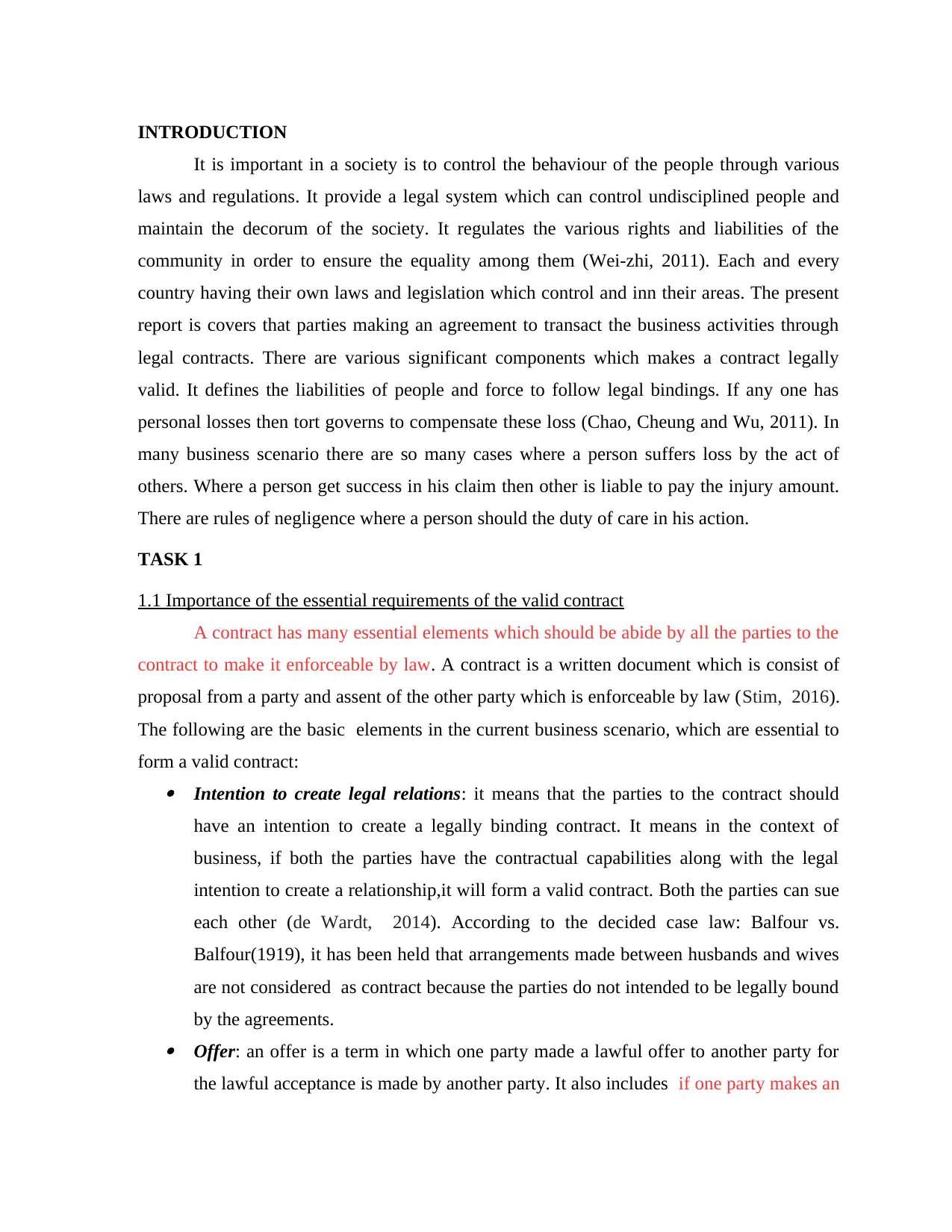
INTRODUCTION
It is important in a society is to control the behaviour of the people through various
laws and regulations. It provide a legal system which can control undisciplined people and
maintain the decorum of the society. It regulates the various rights and liabilities of the
community in order to ensure the equality among them (Wei-zhi, 2011). Each and every
country having their own laws and legislation which control and inn their areas. The present
report is covers that parties making an agreement to transact the business activities through
legal contracts. There are various significant components which makes a contract legally
valid. It defines the liabilities of people and force to follow legal bindings. If any one has
personal losses then tort governs to compensate these loss (Chao, Cheung and Wu, 2011). In
many business scenario there are so many cases where a person suffers loss by the act of
others. Where a person get success in his claim then other is liable to pay the injury amount.
There are rules of negligence where a person should the duty of care in his action.
TASK 1
1.1 Importance of the essential requirements of the valid contract
A contract has many essential elements which should be abide by all the parties to the
contract to make it enforceable by law. A contract is a written document which is consist of
proposal from a party and assent of the other party which is enforceable by law (Stim, 2016).
The following are the basic elements in the current business scenario, which are essential to
form a valid contract:
Intention to create legal relations: it means that the parties to the contract should
have an intention to create a legally binding contract. It means in the context of
business, if both the parties have the contractual capabilities along with the legal
intention to create a relationship,it will form a valid contract. Both the parties can sue
each other (de Wardt, 2014). According to the decided case law: Balfour vs.
Balfour(1919), it has been held that arrangements made between husbands and wives
are not considered as contract because the parties do not intended to be legally bound
by the agreements.
Offer: an offer is a term in which one party made a lawful offer to another party for
the lawful acceptance is made by another party. It also includes if one party makes an
It is important in a society is to control the behaviour of the people through various
laws and regulations. It provide a legal system which can control undisciplined people and
maintain the decorum of the society. It regulates the various rights and liabilities of the
community in order to ensure the equality among them (Wei-zhi, 2011). Each and every
country having their own laws and legislation which control and inn their areas. The present
report is covers that parties making an agreement to transact the business activities through
legal contracts. There are various significant components which makes a contract legally
valid. It defines the liabilities of people and force to follow legal bindings. If any one has
personal losses then tort governs to compensate these loss (Chao, Cheung and Wu, 2011). In
many business scenario there are so many cases where a person suffers loss by the act of
others. Where a person get success in his claim then other is liable to pay the injury amount.
There are rules of negligence where a person should the duty of care in his action.
TASK 1
1.1 Importance of the essential requirements of the valid contract
A contract has many essential elements which should be abide by all the parties to the
contract to make it enforceable by law. A contract is a written document which is consist of
proposal from a party and assent of the other party which is enforceable by law (Stim, 2016).
The following are the basic elements in the current business scenario, which are essential to
form a valid contract:
Intention to create legal relations: it means that the parties to the contract should
have an intention to create a legally binding contract. It means in the context of
business, if both the parties have the contractual capabilities along with the legal
intention to create a relationship,it will form a valid contract. Both the parties can sue
each other (de Wardt, 2014). According to the decided case law: Balfour vs.
Balfour(1919), it has been held that arrangements made between husbands and wives
are not considered as contract because the parties do not intended to be legally bound
by the agreements.
Offer: an offer is a term in which one party made a lawful offer to another party for
the lawful acceptance is made by another party. It also includes if one party makes an
⊘ This is a preview!⊘
Do you want full access?
Subscribe today to unlock all pages.

Trusted by 1+ million students worldwide
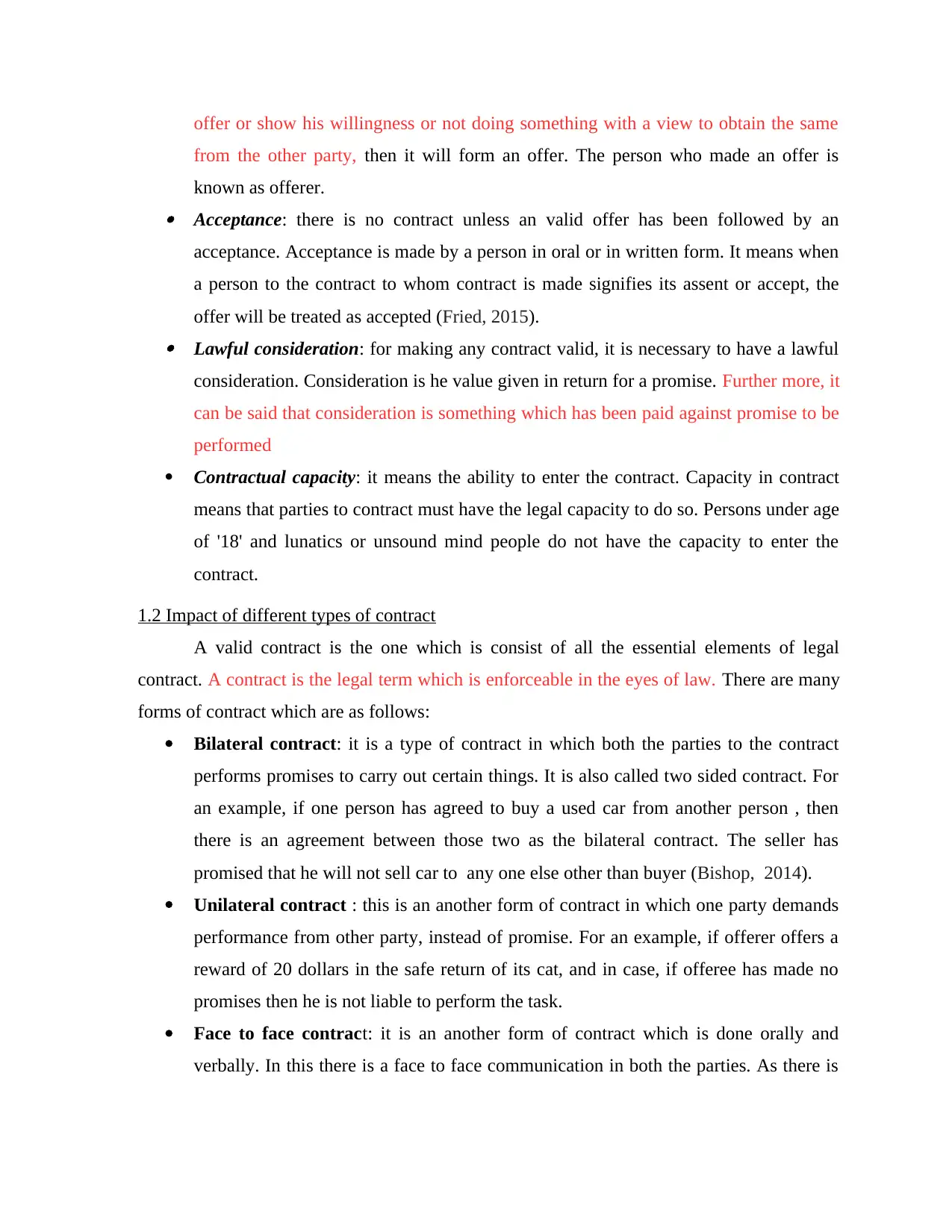
offer or show his willingness or not doing something with a view to obtain the same
from the other party, then it will form an offer. The person who made an offer is
known as offerer.
Acceptance: there is no contract unless an valid offer has been followed by an
acceptance. Acceptance is made by a person in oral or in written form. It means when
a person to the contract to whom contract is made signifies its assent or accept, the
offer will be treated as accepted (Fried, 2015).
Lawful consideration: for making any contract valid, it is necessary to have a lawful
consideration. Consideration is he value given in return for a promise. Further more, it
can be said that consideration is something which has been paid against promise to be
performed
Contractual capacity: it means the ability to enter the contract. Capacity in contract
means that parties to contract must have the legal capacity to do so. Persons under age
of '18' and lunatics or unsound mind people do not have the capacity to enter the
contract.
1.2 Impact of different types of contract
A valid contract is the one which is consist of all the essential elements of legal
contract. A contract is the legal term which is enforceable in the eyes of law. There are many
forms of contract which are as follows:
Bilateral contract: it is a type of contract in which both the parties to the contract
performs promises to carry out certain things. It is also called two sided contract. For
an example, if one person has agreed to buy a used car from another person , then
there is an agreement between those two as the bilateral contract. The seller has
promised that he will not sell car to any one else other than buyer (Bishop, 2014).
Unilateral contract : this is an another form of contract in which one party demands
performance from other party, instead of promise. For an example, if offerer offers a
reward of 20 dollars in the safe return of its cat, and in case, if offeree has made no
promises then he is not liable to perform the task.
Face to face contract: it is an another form of contract which is done orally and
verbally. In this there is a face to face communication in both the parties. As there is
from the other party, then it will form an offer. The person who made an offer is
known as offerer.
Acceptance: there is no contract unless an valid offer has been followed by an
acceptance. Acceptance is made by a person in oral or in written form. It means when
a person to the contract to whom contract is made signifies its assent or accept, the
offer will be treated as accepted (Fried, 2015).
Lawful consideration: for making any contract valid, it is necessary to have a lawful
consideration. Consideration is he value given in return for a promise. Further more, it
can be said that consideration is something which has been paid against promise to be
performed
Contractual capacity: it means the ability to enter the contract. Capacity in contract
means that parties to contract must have the legal capacity to do so. Persons under age
of '18' and lunatics or unsound mind people do not have the capacity to enter the
contract.
1.2 Impact of different types of contract
A valid contract is the one which is consist of all the essential elements of legal
contract. A contract is the legal term which is enforceable in the eyes of law. There are many
forms of contract which are as follows:
Bilateral contract: it is a type of contract in which both the parties to the contract
performs promises to carry out certain things. It is also called two sided contract. For
an example, if one person has agreed to buy a used car from another person , then
there is an agreement between those two as the bilateral contract. The seller has
promised that he will not sell car to any one else other than buyer (Bishop, 2014).
Unilateral contract : this is an another form of contract in which one party demands
performance from other party, instead of promise. For an example, if offerer offers a
reward of 20 dollars in the safe return of its cat, and in case, if offeree has made no
promises then he is not liable to perform the task.
Face to face contract: it is an another form of contract which is done orally and
verbally. In this there is a face to face communication in both the parties. As there is
Paraphrase This Document
Need a fresh take? Get an instant paraphrase of this document with our AI Paraphraser
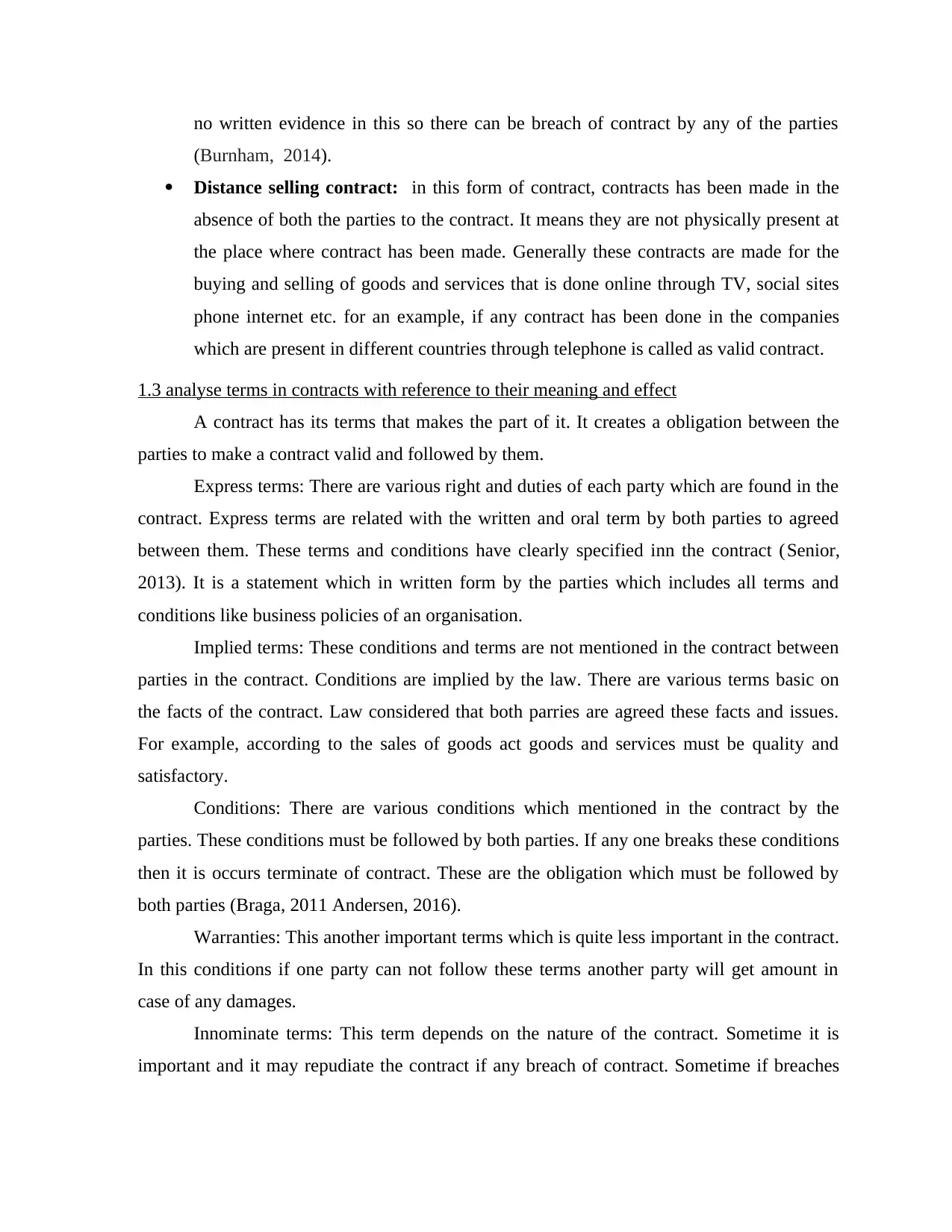
no written evidence in this so there can be breach of contract by any of the parties
(Burnham, 2014).
Distance selling contract: in this form of contract, contracts has been made in the
absence of both the parties to the contract. It means they are not physically present at
the place where contract has been made. Generally these contracts are made for the
buying and selling of goods and services that is done online through TV, social sites
phone internet etc. for an example, if any contract has been done in the companies
which are present in different countries through telephone is called as valid contract.
1.3 analyse terms in contracts with reference to their meaning and effect
A contract has its terms that makes the part of it. It creates a obligation between the
parties to make a contract valid and followed by them.
Express terms: There are various right and duties of each party which are found in the
contract. Express terms are related with the written and oral term by both parties to agreed
between them. These terms and conditions have clearly specified inn the contract (Senior,
2013). It is a statement which in written form by the parties which includes all terms and
conditions like business policies of an organisation.
Implied terms: These conditions and terms are not mentioned in the contract between
parties in the contract. Conditions are implied by the law. There are various terms basic on
the facts of the contract. Law considered that both parries are agreed these facts and issues.
For example, according to the sales of goods act goods and services must be quality and
satisfactory.
Conditions: There are various conditions which mentioned in the contract by the
parties. These conditions must be followed by both parties. If any one breaks these conditions
then it is occurs terminate of contract. These are the obligation which must be followed by
both parties (Braga, 2011 Andersen, 2016).
Warranties: This another important terms which is quite less important in the contract.
In this conditions if one party can not follow these terms another party will get amount in
case of any damages.
Innominate terms: This term depends on the nature of the contract. Sometime it is
important and it may repudiate the contract if any breach of contract. Sometime if breaches
(Burnham, 2014).
Distance selling contract: in this form of contract, contracts has been made in the
absence of both the parties to the contract. It means they are not physically present at
the place where contract has been made. Generally these contracts are made for the
buying and selling of goods and services that is done online through TV, social sites
phone internet etc. for an example, if any contract has been done in the companies
which are present in different countries through telephone is called as valid contract.
1.3 analyse terms in contracts with reference to their meaning and effect
A contract has its terms that makes the part of it. It creates a obligation between the
parties to make a contract valid and followed by them.
Express terms: There are various right and duties of each party which are found in the
contract. Express terms are related with the written and oral term by both parties to agreed
between them. These terms and conditions have clearly specified inn the contract (Senior,
2013). It is a statement which in written form by the parties which includes all terms and
conditions like business policies of an organisation.
Implied terms: These conditions and terms are not mentioned in the contract between
parties in the contract. Conditions are implied by the law. There are various terms basic on
the facts of the contract. Law considered that both parries are agreed these facts and issues.
For example, according to the sales of goods act goods and services must be quality and
satisfactory.
Conditions: There are various conditions which mentioned in the contract by the
parties. These conditions must be followed by both parties. If any one breaks these conditions
then it is occurs terminate of contract. These are the obligation which must be followed by
both parties (Braga, 2011 Andersen, 2016).
Warranties: This another important terms which is quite less important in the contract.
In this conditions if one party can not follow these terms another party will get amount in
case of any damages.
Innominate terms: This term depends on the nature of the contract. Sometime it is
important and it may repudiate the contract if any breach of contract. Sometime if breaches
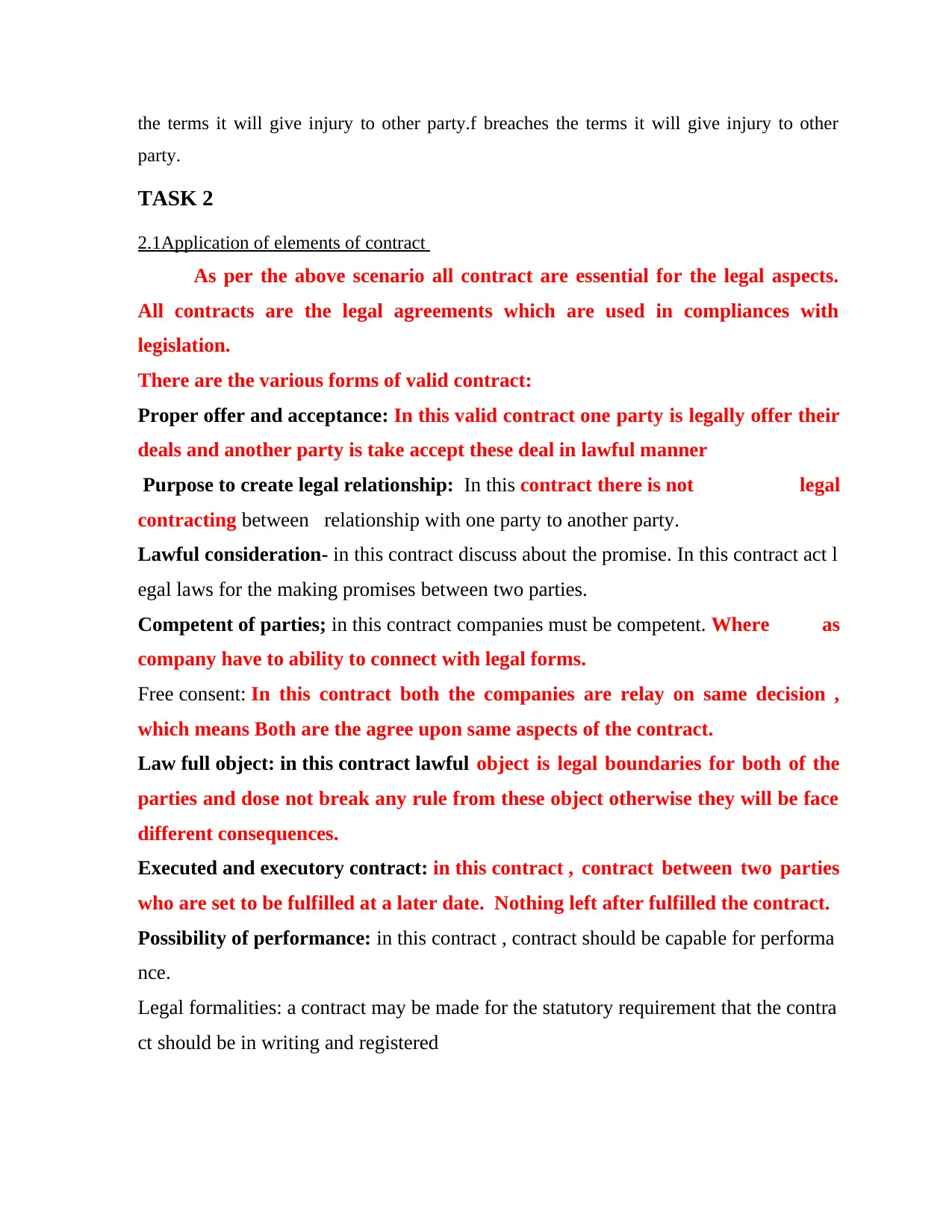
the terms it will give injury to other party.f breaches the terms it will give injury to other
party.
TASK 2
2.1Application of elements of contract
As per the above scenario all contract are essential for the legal aspects.
All contracts are the legal agreements which are used in compliances with
legislation.
There are the various forms of valid contract:
Proper offer and acceptance: In this valid contract one party is legally offer their
deals and another party is take accept these deal in lawful manner
Purpose to create legal relationship: In this contract there is not legal
contracting between relationship with one party to another party.
Lawful consideration- in this contract discuss about the promise. In this contract act l
egal laws for the making promises between two parties.
Competent of parties; in this contract companies must be competent. Where as
company have to ability to connect with legal forms.
Free consent: In this contract both the companies are relay on same decision ,
which means Both are the agree upon same aspects of the contract.
Law full object: in this contract lawful object is legal boundaries for both of the
parties and dose not break any rule from these object otherwise they will be face
different consequences.
Executed and executory contract: in this contract , contract between two parties
who are set to be fulfilled at a later date. Nothing left after fulfilled the contract.
Possibility of performance: in this contract , contract should be capable for performa
nce.
Legal formalities: a contract may be made for the statutory requirement that the contra
ct should be in writing and registered
party.
TASK 2
2.1Application of elements of contract
As per the above scenario all contract are essential for the legal aspects.
All contracts are the legal agreements which are used in compliances with
legislation.
There are the various forms of valid contract:
Proper offer and acceptance: In this valid contract one party is legally offer their
deals and another party is take accept these deal in lawful manner
Purpose to create legal relationship: In this contract there is not legal
contracting between relationship with one party to another party.
Lawful consideration- in this contract discuss about the promise. In this contract act l
egal laws for the making promises between two parties.
Competent of parties; in this contract companies must be competent. Where as
company have to ability to connect with legal forms.
Free consent: In this contract both the companies are relay on same decision ,
which means Both are the agree upon same aspects of the contract.
Law full object: in this contract lawful object is legal boundaries for both of the
parties and dose not break any rule from these object otherwise they will be face
different consequences.
Executed and executory contract: in this contract , contract between two parties
who are set to be fulfilled at a later date. Nothing left after fulfilled the contract.
Possibility of performance: in this contract , contract should be capable for performa
nce.
Legal formalities: a contract may be made for the statutory requirement that the contra
ct should be in writing and registered
⊘ This is a preview!⊘
Do you want full access?
Subscribe today to unlock all pages.

Trusted by 1+ million students worldwide
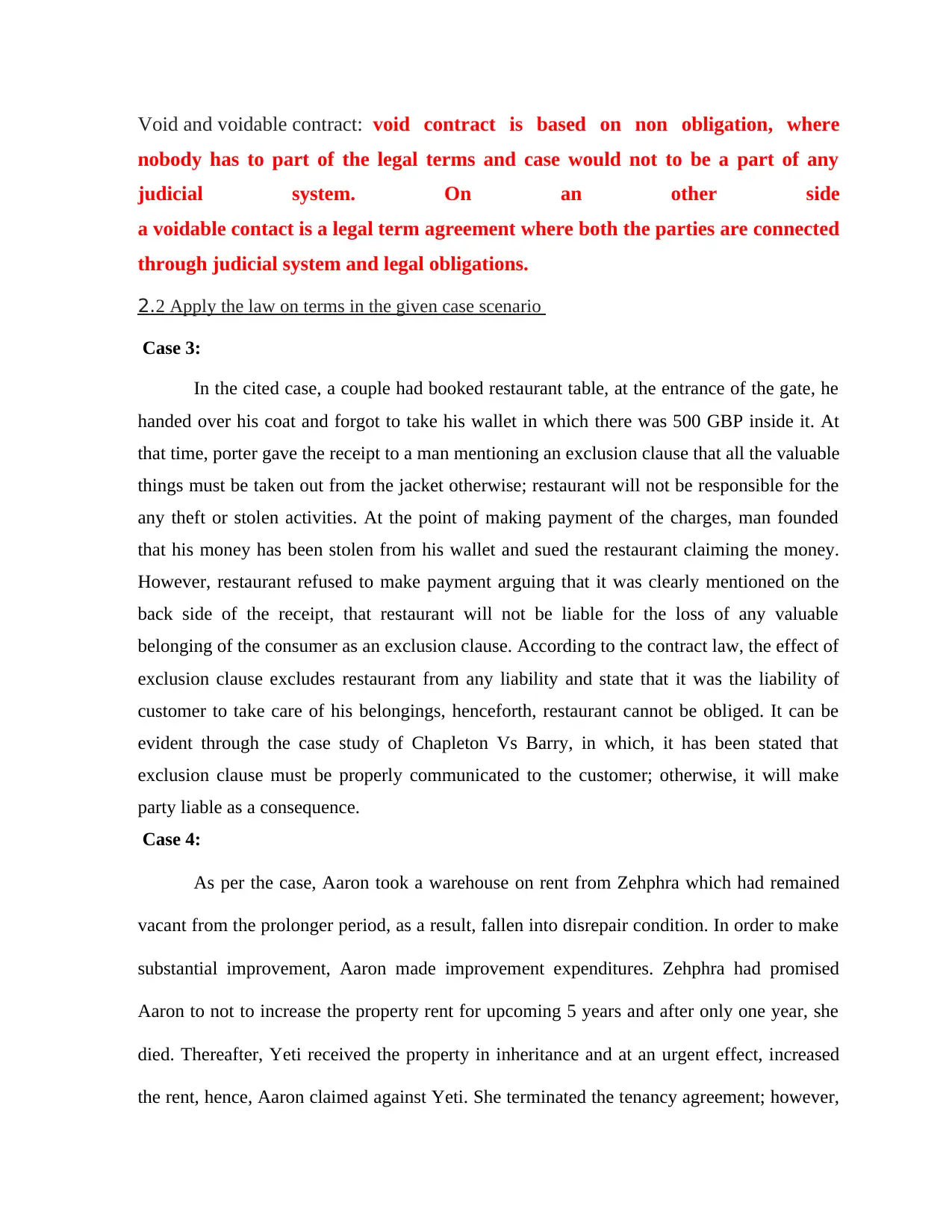
Void and voidable contract: void contract is based on non obligation, where
nobody has to part of the legal terms and case would not to be a part of any
judicial system. On an other side
a voidable contact is a legal term agreement where both the parties are connected
through judicial system and legal obligations.
2.2 Apply the law on terms in the given case scenario
Case 3:
In the cited case, a couple had booked restaurant table, at the entrance of the gate, he
handed over his coat and forgot to take his wallet in which there was 500 GBP inside it. At
that time, porter gave the receipt to a man mentioning an exclusion clause that all the valuable
things must be taken out from the jacket otherwise; restaurant will not be responsible for the
any theft or stolen activities. At the point of making payment of the charges, man founded
that his money has been stolen from his wallet and sued the restaurant claiming the money.
However, restaurant refused to make payment arguing that it was clearly mentioned on the
back side of the receipt, that restaurant will not be liable for the loss of any valuable
belonging of the consumer as an exclusion clause. According to the contract law, the effect of
exclusion clause excludes restaurant from any liability and state that it was the liability of
customer to take care of his belongings, henceforth, restaurant cannot be obliged. It can be
evident through the case study of Chapleton Vs Barry, in which, it has been stated that
exclusion clause must be properly communicated to the customer; otherwise, it will make
party liable as a consequence.
Case 4:
As per the case, Aaron took a warehouse on rent from Zehphra which had remained
vacant from the prolonger period, as a result, fallen into disrepair condition. In order to make
substantial improvement, Aaron made improvement expenditures. Zehphra had promised
Aaron to not to increase the property rent for upcoming 5 years and after only one year, she
died. Thereafter, Yeti received the property in inheritance and at an urgent effect, increased
the rent, hence, Aaron claimed against Yeti. She terminated the tenancy agreement; however,
nobody has to part of the legal terms and case would not to be a part of any
judicial system. On an other side
a voidable contact is a legal term agreement where both the parties are connected
through judicial system and legal obligations.
2.2 Apply the law on terms in the given case scenario
Case 3:
In the cited case, a couple had booked restaurant table, at the entrance of the gate, he
handed over his coat and forgot to take his wallet in which there was 500 GBP inside it. At
that time, porter gave the receipt to a man mentioning an exclusion clause that all the valuable
things must be taken out from the jacket otherwise; restaurant will not be responsible for the
any theft or stolen activities. At the point of making payment of the charges, man founded
that his money has been stolen from his wallet and sued the restaurant claiming the money.
However, restaurant refused to make payment arguing that it was clearly mentioned on the
back side of the receipt, that restaurant will not be liable for the loss of any valuable
belonging of the consumer as an exclusion clause. According to the contract law, the effect of
exclusion clause excludes restaurant from any liability and state that it was the liability of
customer to take care of his belongings, henceforth, restaurant cannot be obliged. It can be
evident through the case study of Chapleton Vs Barry, in which, it has been stated that
exclusion clause must be properly communicated to the customer; otherwise, it will make
party liable as a consequence.
Case 4:
As per the case, Aaron took a warehouse on rent from Zehphra which had remained
vacant from the prolonger period, as a result, fallen into disrepair condition. In order to make
substantial improvement, Aaron made improvement expenditures. Zehphra had promised
Aaron to not to increase the property rent for upcoming 5 years and after only one year, she
died. Thereafter, Yeti received the property in inheritance and at an urgent effect, increased
the rent, hence, Aaron claimed against Yeti. She terminated the tenancy agreement; however,
Paraphrase This Document
Need a fresh take? Get an instant paraphrase of this document with our AI Paraphraser
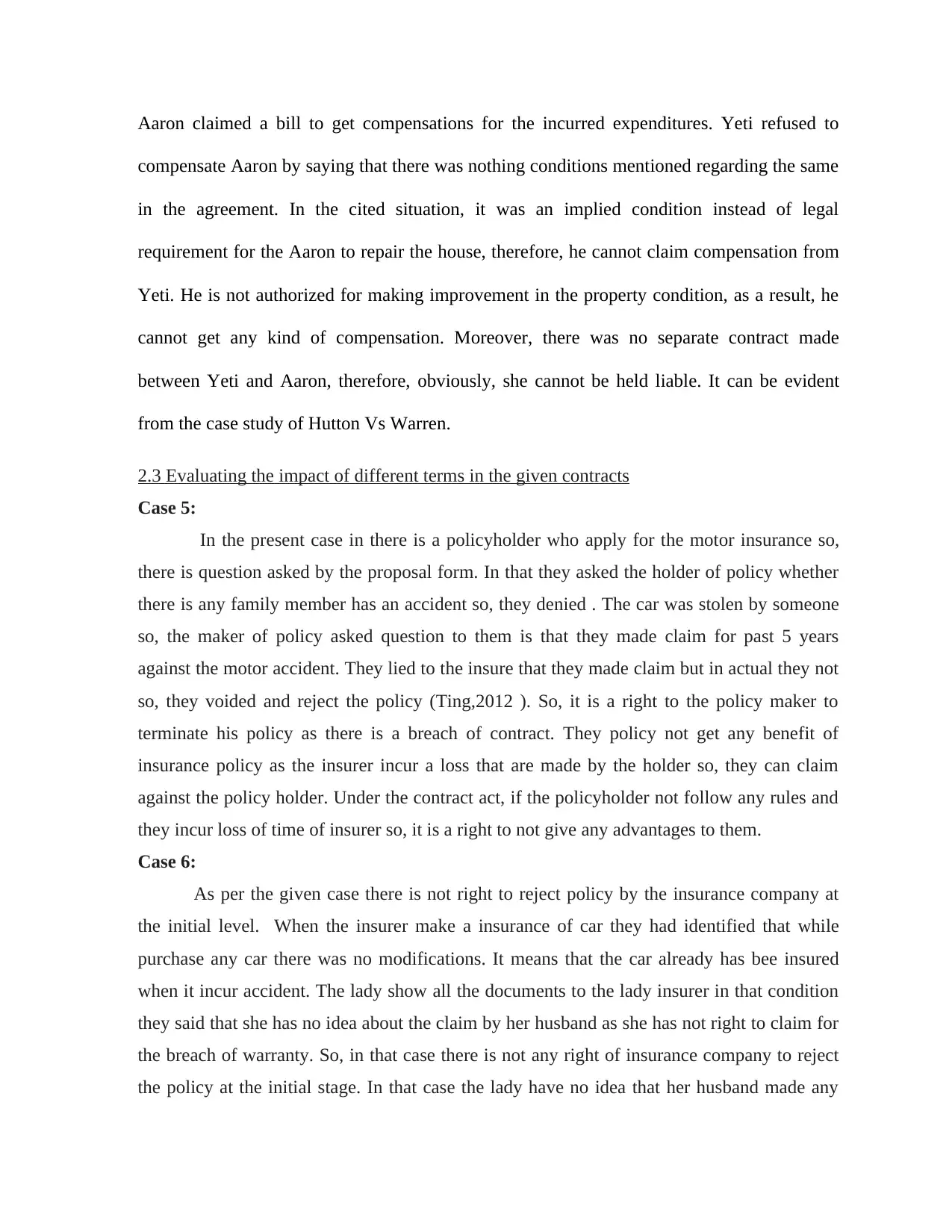
Aaron claimed a bill to get compensations for the incurred expenditures. Yeti refused to
compensate Aaron by saying that there was nothing conditions mentioned regarding the same
in the agreement. In the cited situation, it was an implied condition instead of legal
requirement for the Aaron to repair the house, therefore, he cannot claim compensation from
Yeti. He is not authorized for making improvement in the property condition, as a result, he
cannot get any kind of compensation. Moreover, there was no separate contract made
between Yeti and Aaron, therefore, obviously, she cannot be held liable. It can be evident
from the case study of Hutton Vs Warren.
2.3 Evaluating the impact of different terms in the given contracts
Case 5:
In the present case in there is a policyholder who apply for the motor insurance so,
there is question asked by the proposal form. In that they asked the holder of policy whether
there is any family member has an accident so, they denied . The car was stolen by someone
so, the maker of policy asked question to them is that they made claim for past 5 years
against the motor accident. They lied to the insure that they made claim but in actual they not
so, they voided and reject the policy (Ting,2012 ). So, it is a right to the policy maker to
terminate his policy as there is a breach of contract. They policy not get any benefit of
insurance policy as the insurer incur a loss that are made by the holder so, they can claim
against the policy holder. Under the contract act, if the policyholder not follow any rules and
they incur loss of time of insurer so, it is a right to not give any advantages to them.
Case 6:
As per the given case there is not right to reject policy by the insurance company at
the initial level. When the insurer make a insurance of car they had identified that while
purchase any car there was no modifications. It means that the car already has bee insured
when it incur accident. The lady show all the documents to the lady insurer in that condition
they said that she has no idea about the claim by her husband as she has not right to claim for
the breach of warranty. So, in that case there is not any right of insurance company to reject
the policy at the initial stage. In that case the lady have no idea that her husband made any
compensate Aaron by saying that there was nothing conditions mentioned regarding the same
in the agreement. In the cited situation, it was an implied condition instead of legal
requirement for the Aaron to repair the house, therefore, he cannot claim compensation from
Yeti. He is not authorized for making improvement in the property condition, as a result, he
cannot get any kind of compensation. Moreover, there was no separate contract made
between Yeti and Aaron, therefore, obviously, she cannot be held liable. It can be evident
from the case study of Hutton Vs Warren.
2.3 Evaluating the impact of different terms in the given contracts
Case 5:
In the present case in there is a policyholder who apply for the motor insurance so,
there is question asked by the proposal form. In that they asked the holder of policy whether
there is any family member has an accident so, they denied . The car was stolen by someone
so, the maker of policy asked question to them is that they made claim for past 5 years
against the motor accident. They lied to the insure that they made claim but in actual they not
so, they voided and reject the policy (Ting,2012 ). So, it is a right to the policy maker to
terminate his policy as there is a breach of contract. They policy not get any benefit of
insurance policy as the insurer incur a loss that are made by the holder so, they can claim
against the policy holder. Under the contract act, if the policyholder not follow any rules and
they incur loss of time of insurer so, it is a right to not give any advantages to them.
Case 6:
As per the given case there is not right to reject policy by the insurance company at
the initial level. When the insurer make a insurance of car they had identified that while
purchase any car there was no modifications. It means that the car already has bee insured
when it incur accident. The lady show all the documents to the lady insurer in that condition
they said that she has no idea about the claim by her husband as she has not right to claim for
the breach of warranty. So, in that case there is not any right of insurance company to reject
the policy at the initial stage. In that case the lady have no idea that her husband made any
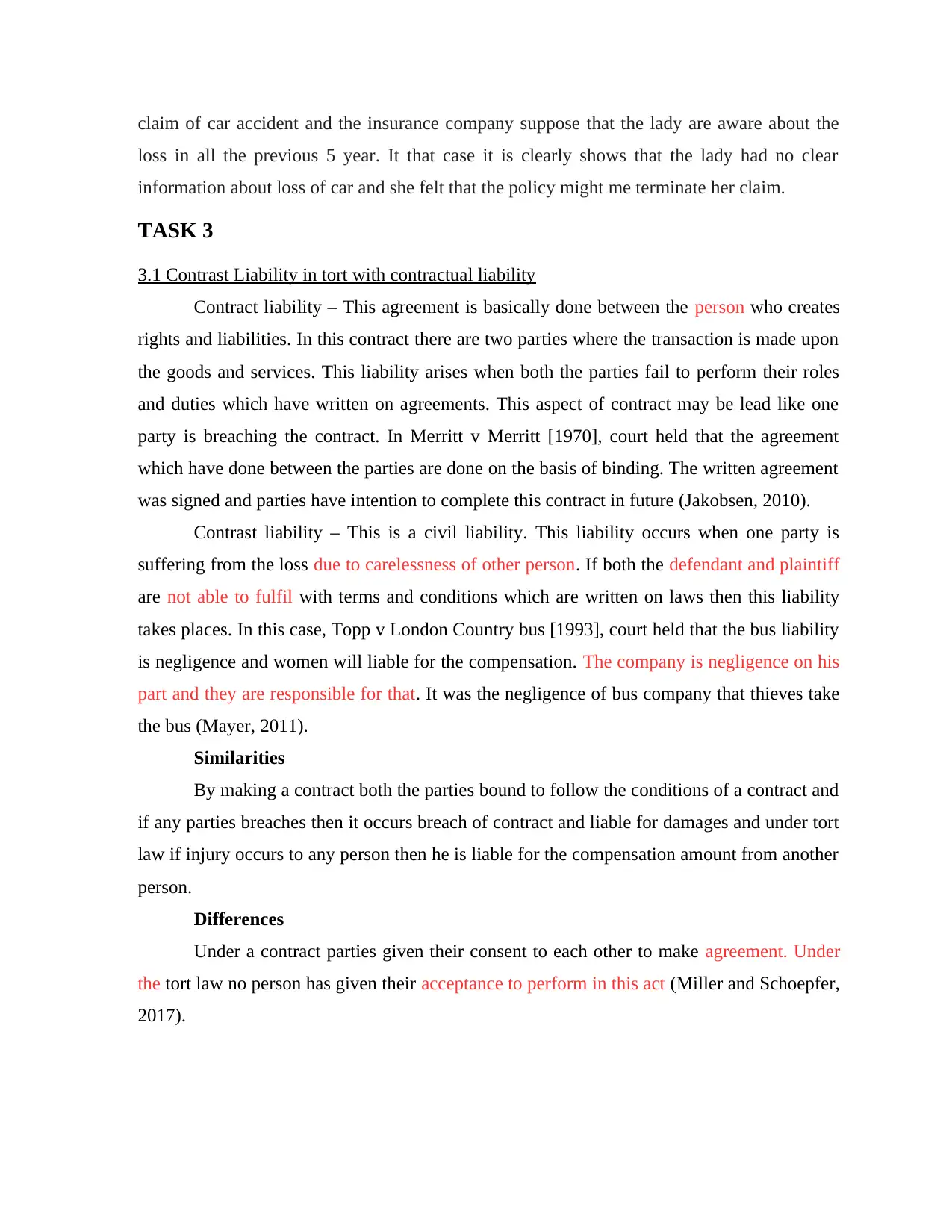
claim of car accident and the insurance company suppose that the lady are aware about the
loss in all the previous 5 year. It that case it is clearly shows that the lady had no clear
information about loss of car and she felt that the policy might me terminate her claim.
TASK 3
3.1 Contrast Liability in tort with contractual liability
Contract liability – This agreement is basically done between the person who creates
rights and liabilities. In this contract there are two parties where the transaction is made upon
the goods and services. This liability arises when both the parties fail to perform their roles
and duties which have written on agreements. This aspect of contract may be lead like one
party is breaching the contract. In Merritt v Merritt [1970], court held that the agreement
which have done between the parties are done on the basis of binding. The written agreement
was signed and parties have intention to complete this contract in future (Jakobsen, 2010).
Contrast liability – This is a civil liability. This liability occurs when one party is
suffering from the loss due to carelessness of other person. If both the defendant and plaintiff
are not able to fulfil with terms and conditions which are written on laws then this liability
takes places. In this case, Topp v London Country bus [1993], court held that the bus liability
is negligence and women will liable for the compensation. The company is negligence on his
part and they are responsible for that. It was the negligence of bus company that thieves take
the bus (Mayer, 2011).
Similarities
By making a contract both the parties bound to follow the conditions of a contract and
if any parties breaches then it occurs breach of contract and liable for damages and under tort
law if injury occurs to any person then he is liable for the compensation amount from another
person.
Differences
Under a contract parties given their consent to each other to make agreement. Under
the tort law no person has given their acceptance to perform in this act (Miller and Schoepfer,
2017).
loss in all the previous 5 year. It that case it is clearly shows that the lady had no clear
information about loss of car and she felt that the policy might me terminate her claim.
TASK 3
3.1 Contrast Liability in tort with contractual liability
Contract liability – This agreement is basically done between the person who creates
rights and liabilities. In this contract there are two parties where the transaction is made upon
the goods and services. This liability arises when both the parties fail to perform their roles
and duties which have written on agreements. This aspect of contract may be lead like one
party is breaching the contract. In Merritt v Merritt [1970], court held that the agreement
which have done between the parties are done on the basis of binding. The written agreement
was signed and parties have intention to complete this contract in future (Jakobsen, 2010).
Contrast liability – This is a civil liability. This liability occurs when one party is
suffering from the loss due to carelessness of other person. If both the defendant and plaintiff
are not able to fulfil with terms and conditions which are written on laws then this liability
takes places. In this case, Topp v London Country bus [1993], court held that the bus liability
is negligence and women will liable for the compensation. The company is negligence on his
part and they are responsible for that. It was the negligence of bus company that thieves take
the bus (Mayer, 2011).
Similarities
By making a contract both the parties bound to follow the conditions of a contract and
if any parties breaches then it occurs breach of contract and liable for damages and under tort
law if injury occurs to any person then he is liable for the compensation amount from another
person.
Differences
Under a contract parties given their consent to each other to make agreement. Under
the tort law no person has given their acceptance to perform in this act (Miller and Schoepfer,
2017).
⊘ This is a preview!⊘
Do you want full access?
Subscribe today to unlock all pages.

Trusted by 1+ million students worldwide
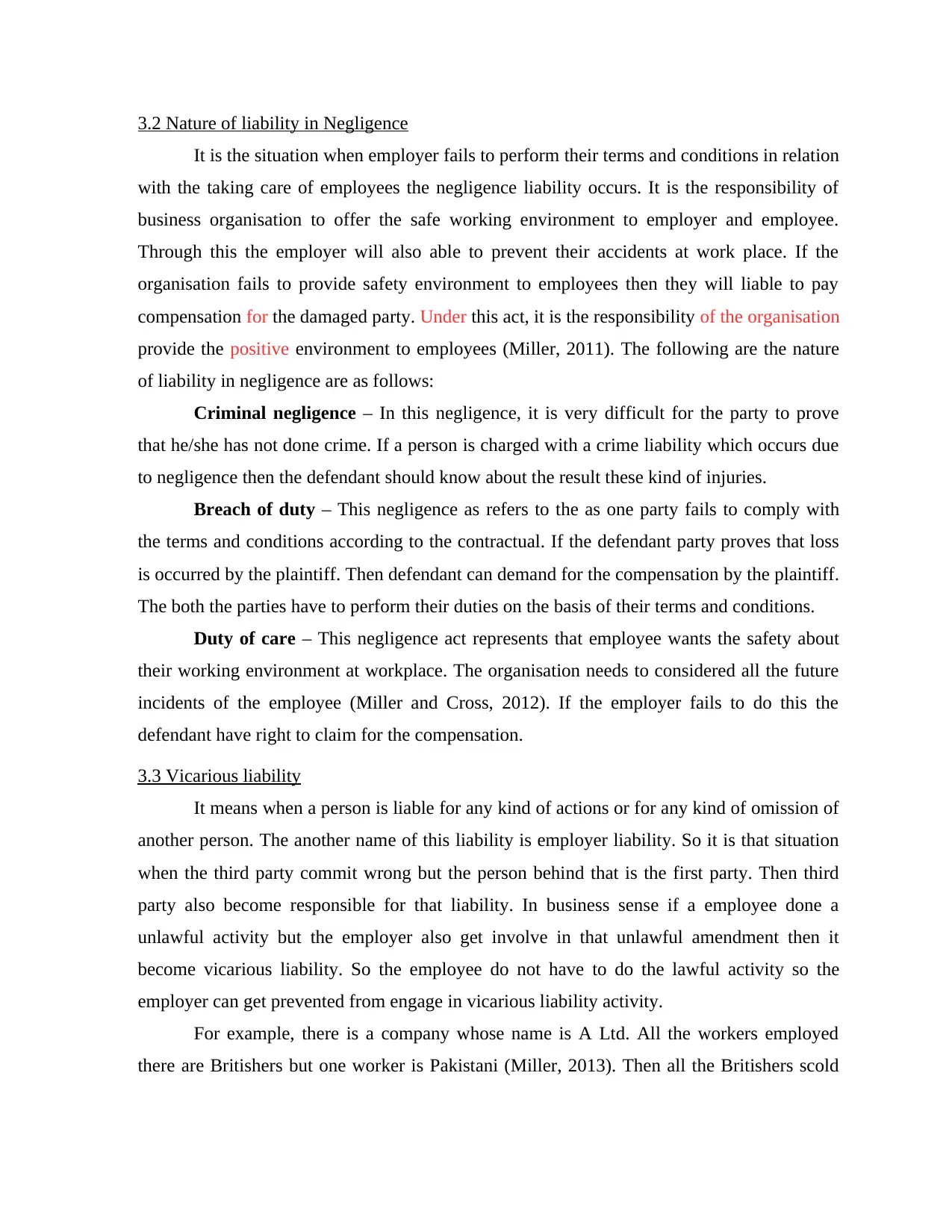
3.2 Nature of liability in Negligence
It is the situation when employer fails to perform their terms and conditions in relation
with the taking care of employees the negligence liability occurs. It is the responsibility of
business organisation to offer the safe working environment to employer and employee.
Through this the employer will also able to prevent their accidents at work place. If the
organisation fails to provide safety environment to employees then they will liable to pay
compensation for the damaged party. Under this act, it is the responsibility of the organisation
provide the positive environment to employees (Miller, 2011). The following are the nature
of liability in negligence are as follows:
Criminal negligence – In this negligence, it is very difficult for the party to prove
that he/she has not done crime. If a person is charged with a crime liability which occurs due
to negligence then the defendant should know about the result these kind of injuries.
Breach of duty – This negligence as refers to the as one party fails to comply with
the terms and conditions according to the contractual. If the defendant party proves that loss
is occurred by the plaintiff. Then defendant can demand for the compensation by the plaintiff.
The both the parties have to perform their duties on the basis of their terms and conditions.
Duty of care – This negligence act represents that employee wants the safety about
their working environment at workplace. The organisation needs to considered all the future
incidents of the employee (Miller and Cross, 2012). If the employer fails to do this the
defendant have right to claim for the compensation.
3.3 Vicarious liability
It means when a person is liable for any kind of actions or for any kind of omission of
another person. The another name of this liability is employer liability. So it is that situation
when the third party commit wrong but the person behind that is the first party. Then third
party also become responsible for that liability. In business sense if a employee done a
unlawful activity but the employer also get involve in that unlawful amendment then it
become vicarious liability. So the employee do not have to do the lawful activity so the
employer can get prevented from engage in vicarious liability activity.
For example, there is a company whose name is A Ltd. All the workers employed
there are Britishers but one worker is Pakistani (Miller, 2013). Then all the Britishers scold
It is the situation when employer fails to perform their terms and conditions in relation
with the taking care of employees the negligence liability occurs. It is the responsibility of
business organisation to offer the safe working environment to employer and employee.
Through this the employer will also able to prevent their accidents at work place. If the
organisation fails to provide safety environment to employees then they will liable to pay
compensation for the damaged party. Under this act, it is the responsibility of the organisation
provide the positive environment to employees (Miller, 2011). The following are the nature
of liability in negligence are as follows:
Criminal negligence – In this negligence, it is very difficult for the party to prove
that he/she has not done crime. If a person is charged with a crime liability which occurs due
to negligence then the defendant should know about the result these kind of injuries.
Breach of duty – This negligence as refers to the as one party fails to comply with
the terms and conditions according to the contractual. If the defendant party proves that loss
is occurred by the plaintiff. Then defendant can demand for the compensation by the plaintiff.
The both the parties have to perform their duties on the basis of their terms and conditions.
Duty of care – This negligence act represents that employee wants the safety about
their working environment at workplace. The organisation needs to considered all the future
incidents of the employee (Miller and Cross, 2012). If the employer fails to do this the
defendant have right to claim for the compensation.
3.3 Vicarious liability
It means when a person is liable for any kind of actions or for any kind of omission of
another person. The another name of this liability is employer liability. So it is that situation
when the third party commit wrong but the person behind that is the first party. Then third
party also become responsible for that liability. In business sense if a employee done a
unlawful activity but the employer also get involve in that unlawful amendment then it
become vicarious liability. So the employee do not have to do the lawful activity so the
employer can get prevented from engage in vicarious liability activity.
For example, there is a company whose name is A Ltd. All the workers employed
there are Britishers but one worker is Pakistani (Miller, 2013). Then all the Britishers scold
Paraphrase This Document
Need a fresh take? Get an instant paraphrase of this document with our AI Paraphraser
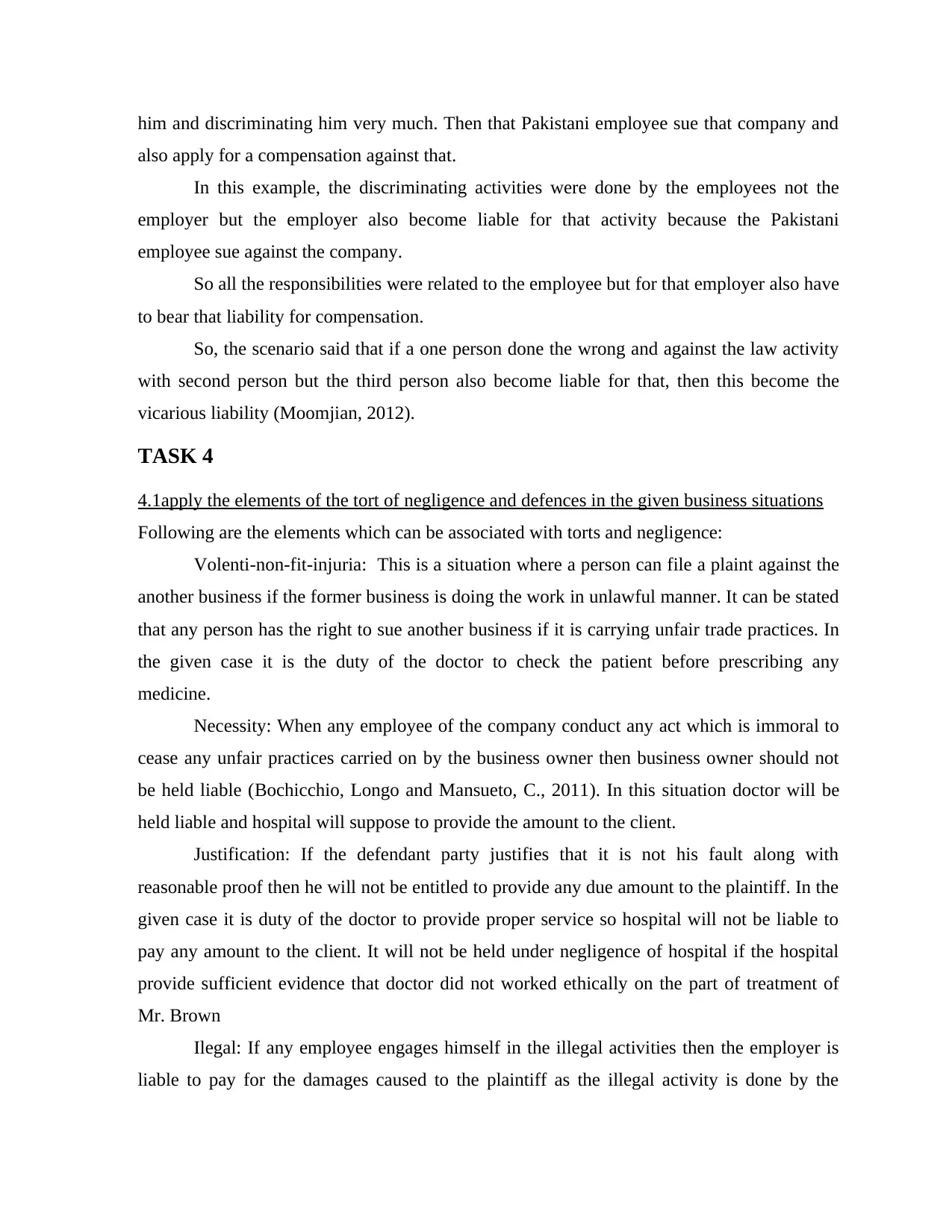
him and discriminating him very much. Then that Pakistani employee sue that company and
also apply for a compensation against that.
In this example, the discriminating activities were done by the employees not the
employer but the employer also become liable for that activity because the Pakistani
employee sue against the company.
So all the responsibilities were related to the employee but for that employer also have
to bear that liability for compensation.
So, the scenario said that if a one person done the wrong and against the law activity
with second person but the third person also become liable for that, then this become the
vicarious liability (Moomjian, 2012).
TASK 4
4.1apply the elements of the tort of negligence and defences in the given business situations
Following are the elements which can be associated with torts and negligence:
Volenti-non-fit-injuria: This is a situation where a person can file a plaint against the
another business if the former business is doing the work in unlawful manner. It can be stated
that any person has the right to sue another business if it is carrying unfair trade practices. In
the given case it is the duty of the doctor to check the patient before prescribing any
medicine.
Necessity: When any employee of the company conduct any act which is immoral to
cease any unfair practices carried on by the business owner then business owner should not
be held liable (Bochicchio, Longo and Mansueto, C., 2011). In this situation doctor will be
held liable and hospital will suppose to provide the amount to the client.
Justification: If the defendant party justifies that it is not his fault along with
reasonable proof then he will not be entitled to provide any due amount to the plaintiff. In the
given case it is duty of the doctor to provide proper service so hospital will not be liable to
pay any amount to the client. It will not be held under negligence of hospital if the hospital
provide sufficient evidence that doctor did not worked ethically on the part of treatment of
Mr. Brown
Ilegal: If any employee engages himself in the illegal activities then the employer is
liable to pay for the damages caused to the plaintiff as the illegal activity is done by the
also apply for a compensation against that.
In this example, the discriminating activities were done by the employees not the
employer but the employer also become liable for that activity because the Pakistani
employee sue against the company.
So all the responsibilities were related to the employee but for that employer also have
to bear that liability for compensation.
So, the scenario said that if a one person done the wrong and against the law activity
with second person but the third person also become liable for that, then this become the
vicarious liability (Moomjian, 2012).
TASK 4
4.1apply the elements of the tort of negligence and defences in the given business situations
Following are the elements which can be associated with torts and negligence:
Volenti-non-fit-injuria: This is a situation where a person can file a plaint against the
another business if the former business is doing the work in unlawful manner. It can be stated
that any person has the right to sue another business if it is carrying unfair trade practices. In
the given case it is the duty of the doctor to check the patient before prescribing any
medicine.
Necessity: When any employee of the company conduct any act which is immoral to
cease any unfair practices carried on by the business owner then business owner should not
be held liable (Bochicchio, Longo and Mansueto, C., 2011). In this situation doctor will be
held liable and hospital will suppose to provide the amount to the client.
Justification: If the defendant party justifies that it is not his fault along with
reasonable proof then he will not be entitled to provide any due amount to the plaintiff. In the
given case it is duty of the doctor to provide proper service so hospital will not be liable to
pay any amount to the client. It will not be held under negligence of hospital if the hospital
provide sufficient evidence that doctor did not worked ethically on the part of treatment of
Mr. Brown
Ilegal: If any employee engages himself in the illegal activities then the employer is
liable to pay for the damages caused to the plaintiff as the illegal activity is done by the
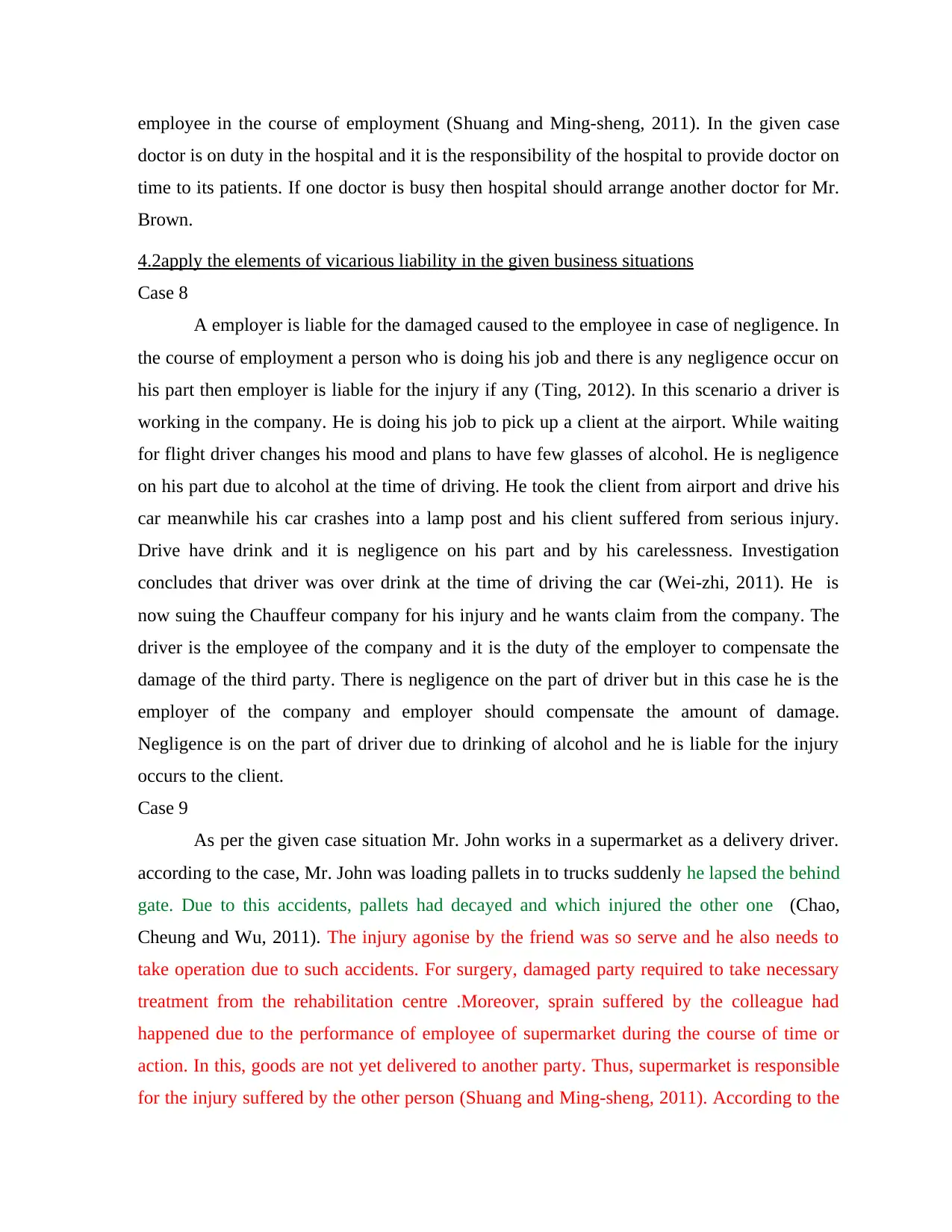
employee in the course of employment (Shuang and Ming-sheng, 2011). In the given case
doctor is on duty in the hospital and it is the responsibility of the hospital to provide doctor on
time to its patients. If one doctor is busy then hospital should arrange another doctor for Mr.
Brown.
4.2apply the elements of vicarious liability in the given business situations
Case 8
A employer is liable for the damaged caused to the employee in case of negligence. In
the course of employment a person who is doing his job and there is any negligence occur on
his part then employer is liable for the injury if any (Ting, 2012). In this scenario a driver is
working in the company. He is doing his job to pick up a client at the airport. While waiting
for flight driver changes his mood and plans to have few glasses of alcohol. He is negligence
on his part due to alcohol at the time of driving. He took the client from airport and drive his
car meanwhile his car crashes into a lamp post and his client suffered from serious injury.
Drive have drink and it is negligence on his part and by his carelessness. Investigation
concludes that driver was over drink at the time of driving the car (Wei-zhi, 2011). He is
now suing the Chauffeur company for his injury and he wants claim from the company. The
driver is the employee of the company and it is the duty of the employer to compensate the
damage of the third party. There is negligence on the part of driver but in this case he is the
employer of the company and employer should compensate the amount of damage.
Negligence is on the part of driver due to drinking of alcohol and he is liable for the injury
occurs to the client.
Case 9
As per the given case situation Mr. John works in a supermarket as a delivery driver.
according to the case, Mr. John was loading pallets in to trucks suddenly he lapsed the behind
gate. Due to this accidents, pallets had decayed and which injured the other one (Chao,
Cheung and Wu, 2011). The injury agonise by the friend was so serve and he also needs to
take operation due to such accidents. For surgery, damaged party required to take necessary
treatment from the rehabilitation centre .Moreover, sprain suffered by the colleague had
happened due to the performance of employee of supermarket during the course of time or
action. In this, goods are not yet delivered to another party. Thus, supermarket is responsible
for the injury suffered by the other person (Shuang and Ming-sheng, 2011). According to the
doctor is on duty in the hospital and it is the responsibility of the hospital to provide doctor on
time to its patients. If one doctor is busy then hospital should arrange another doctor for Mr.
Brown.
4.2apply the elements of vicarious liability in the given business situations
Case 8
A employer is liable for the damaged caused to the employee in case of negligence. In
the course of employment a person who is doing his job and there is any negligence occur on
his part then employer is liable for the injury if any (Ting, 2012). In this scenario a driver is
working in the company. He is doing his job to pick up a client at the airport. While waiting
for flight driver changes his mood and plans to have few glasses of alcohol. He is negligence
on his part due to alcohol at the time of driving. He took the client from airport and drive his
car meanwhile his car crashes into a lamp post and his client suffered from serious injury.
Drive have drink and it is negligence on his part and by his carelessness. Investigation
concludes that driver was over drink at the time of driving the car (Wei-zhi, 2011). He is
now suing the Chauffeur company for his injury and he wants claim from the company. The
driver is the employee of the company and it is the duty of the employer to compensate the
damage of the third party. There is negligence on the part of driver but in this case he is the
employer of the company and employer should compensate the amount of damage.
Negligence is on the part of driver due to drinking of alcohol and he is liable for the injury
occurs to the client.
Case 9
As per the given case situation Mr. John works in a supermarket as a delivery driver.
according to the case, Mr. John was loading pallets in to trucks suddenly he lapsed the behind
gate. Due to this accidents, pallets had decayed and which injured the other one (Chao,
Cheung and Wu, 2011). The injury agonise by the friend was so serve and he also needs to
take operation due to such accidents. For surgery, damaged party required to take necessary
treatment from the rehabilitation centre .Moreover, sprain suffered by the colleague had
happened due to the performance of employee of supermarket during the course of time or
action. In this, goods are not yet delivered to another party. Thus, supermarket is responsible
for the injury suffered by the other person (Shuang and Ming-sheng, 2011). According to the
⊘ This is a preview!⊘
Do you want full access?
Subscribe today to unlock all pages.

Trusted by 1+ million students worldwide
1 out of 15
Related Documents
Your All-in-One AI-Powered Toolkit for Academic Success.
+13062052269
info@desklib.com
Available 24*7 on WhatsApp / Email
![[object Object]](/_next/static/media/star-bottom.7253800d.svg)
Unlock your academic potential
Copyright © 2020–2025 A2Z Services. All Rights Reserved. Developed and managed by ZUCOL.





